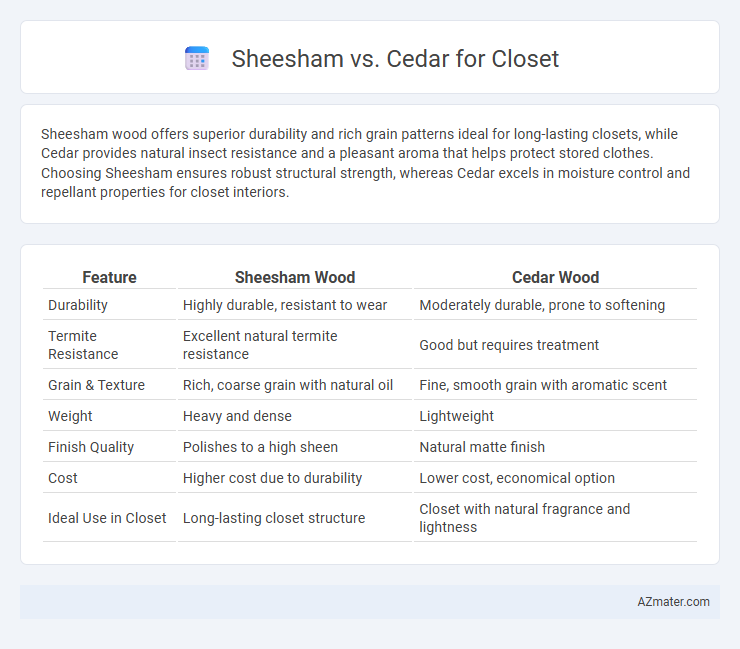Sheesham wood offers superior durability and rich grain patterns ideal for long-lasting closets, while Cedar provides natural insect resistance and a pleasant aroma that helps protect stored clothes. Choosing Sheesham ensures robust structural strength, whereas Cedar excels in moisture control and repellant properties for closet interiors.
Table of Comparison
| Feature | Sheesham Wood | Cedar Wood |
|---|---|---|
| Durability | Highly durable, resistant to wear | Moderately durable, prone to softening |
| Termite Resistance | Excellent natural termite resistance | Good but requires treatment |
| Grain & Texture | Rich, coarse grain with natural oil | Fine, smooth grain with aromatic scent |
| Weight | Heavy and dense | Lightweight |
| Finish Quality | Polishes to a high sheen | Natural matte finish |
| Cost | Higher cost due to durability | Lower cost, economical option |
| Ideal Use in Closet | Long-lasting closet structure | Closet with natural fragrance and lightness |
Introduction to Sheesham and Cedar Wood
Sheesham wood, also known as Indian rosewood, is prized for its rich grain patterns, natural durability, and resistance to termite attacks, making it a popular choice for closet construction. Cedar wood features a distinctive aroma, natural insect-repellent properties, and excellent moisture resistance, helping to protect clothes from mold and moth damage. Both woods offer unique benefits, with Sheesham valued for its strength and aesthetic appeal, while Cedar is favored for its protective qualities and lightweight nature.
Appearance and Aesthetic Differences
Sheesham wood features rich, dark grains with natural variations that create a warm, sophisticated look ideal for stylish closet designs. Cedar offers a lighter, reddish tone with a smooth texture and distinctive aromatic qualities, enhancing closet aesthetics with a fresh, rustic charm. The contrast between Sheesham's deep, glossy finish and Cedar's soft, velvety appearance allows for tailored closet styles ranging from classic elegance to natural simplicity.
Durability and Lifespan Comparison
Sheesham wood, known for its high density and natural oils, offers exceptional durability and resistance to decay, making it ideal for long-lasting closets. Cedar, while slightly softer, provides natural insect-repellent properties and excellent resistance to moisture, contributing to a lifespan that can exceed decades with proper maintenance. Both woods deliver robust performance; Sheesham excels in hardness and wear resistance, whereas Cedar stands out for its aromatic qualities and natural preservation attributes.
Resistance to Pests and Mold
Sheesham wood exhibits high natural resistance to pests and mold due to its dense grain and natural oils, making it an excellent choice for closets in humid environments. Cedar is renowned for its strong aromatic oils that repel insects and inhibit mold growth, providing long-lasting protection for stored items. Both woods offer reliable durability against biological damage, but cedar's scent and natural pest-repellent properties often make it the preferred option for mold and pest resistance in closet construction.
Fragrance and Natural Aroma
Sheesham wood offers a rich, earthy fragrance with natural oil content that emits a warm, inviting aroma ideal for closets and wardrobes. Cedarwood is renowned for its strong, distinctive scent that naturally repels moths and insects, making it a preferred choice for preserving fabrics. Both woods provide long-lasting natural aromas, but cedar's pungent aroma is more potent compared to the subtle, sweet scent of Sheesham.
Cost and Availability
Sheesham wood is generally more affordable than Cedar, offering a cost-effective option for closet construction without compromising durability. Widely available in South Asia and increasingly accessible globally, Sheesham's supply remains steady compared to Cedar, which tends to be pricier due to limited regional availability. Cedar's higher cost reflects its natural resistance to pests and moisture, but Sheesham's competitive price and good accessibility make it a preferred choice for budget-conscious closet projects.
Sustainability and Environmental Impact
Sheesham wood, known for its durability and natural resistance to pests, is often sourced from sustainable plantations, making it an eco-friendly choice for closets due to its renewable growth and minimal chemical treatment. Cedar wood offers natural insect-repellent properties and excellent moisture resistance, with many suppliers focusing on responsible harvesting to reduce deforestation impact. Both woods contribute to sustainable furniture practices when sourced through certified forestry programs like FSC, ensuring reduced carbon footprint and long-term environmental benefits.
Maintenance Requirements
Sheesham wood requires regular oiling and polishing to maintain its rich texture and prevent cracking, making it moderately high in maintenance for closets. Cedar boasts natural oils that resist moisture, insects, and decay, resulting in lower upkeep and a longer-lasting finish without frequent treatments. Choosing cedar minimizes the need for chemical maintenance, while sheesham demands consistent care to preserve its aesthetic appeal.
Best Applications for Sheesham and Cedar in Closets
Sheesham wood is ideal for closet frameworks and drawers due to its durability, natural resistance to termites, and attractive grain patterns, making it perfect for both structural support and visible components. Cedar wood is best suited for closet interiors, particularly shelves and linings, as its natural aromatic oils repel moths and prevent moisture buildup, preserving garments and textiles. Both woods complement each other where Sheesham provides sturdy construction and Cedar offers protective, fragrance-rich storage environments.
Final Verdict: Which Wood is Better for Your Closet?
Sheesham wood offers exceptional durability and rich grain patterns, making it ideal for a long-lasting, visually appealing closet. Cedar, known for its natural insect-repelling properties and pleasant aroma, is perfect for protecting clothes and maintaining freshness. For closets requiring robust strength and classic elegance, Sheesham is better, whereas Cedar suits those prioritizing natural protection and scent.

Infographic: Sheesham vs Cedar for Closet
 azmater.com
azmater.com